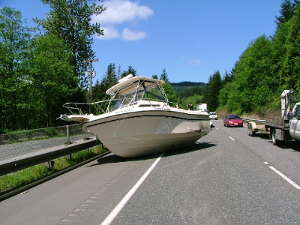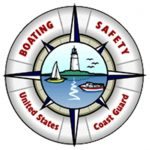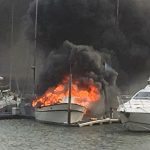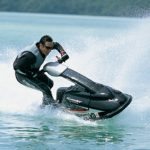Over 95% of recreational boats in the U. S. are trailerable. If you’re a trailer-boater like me, you know that our recurring nightmare is looking into the rear view mirror and seeing our trailer, with boat astride, departing company with our tow vehicle. I’ve had friends lose their rigs, one on an interstate highway as he watched his 28 footer rolling through the median. So if you don’t think TRAILER SAFETY has a place in a notebook devoted to BOATING SAFETY, you probably have never towed a boat!
TOP TRAILER BOAT GAS STATION TIPS
The ability to easily explore new cruising grounds and filling up on the fly are synonymous with trailer boating. But filling up at a gas station requires a special set of precautions, says Caroline Ajootian, director of the BoatU.S. Consumer Protection Bureau.
“We have received a number of reports this summer of gas accidentally exiting fuel filler pipes and vents on trailered boats,” says Ajootian. “This ‘blow back’ can occur for many reasons.”
To help you safely refuel at gas stations, the Boat Owners Association of The United States has these trailer boat gas station tips:
Know fuel tank capacity: To prevent overfilling, trailer boaters should know their vessel’s precise fuel capacity. This basic information is critical to a safe fill-up.
Never use your boat’s gas gauge while filling up: If you are not sure of your tank’s capacity, never turn on the vessel’s ignition switch to view your boat’s gas gauge. Sparking can sometimes occur.
Don’t walk away: While filling up you may be tempted to save time and get ice, bait and snacks at the gas station’s mini-mart. Don’t. Leaving a refueling vessel unattended removes the biggest layer of safety – you.
After half-full, slow down: Slowing the flow of gas after reaching your tank’s half-full mark will reduce the chances of blowback.
Where is my gas tank vent? Is the vent forward or near the transom? Understand how your filler tube, tank and vent are installed. If your boat is not level on its trailer you may find fuel inadvertently exiting the vent, or unable to fill tanks completely.
Fill evenly: If you have two or more tanks, distribute fuel equally. Loading up one tank more than another could put your boat-and-trailer-combo dangerously out of balance.
Never top off: Fuel that is pumped from cool, below ground holding tanks into your boat’s tank – warmed by hot asphalt below and bright sun above – will expand. Not only is this a safety hazard, but you could pollute.
Always check the hubs: Every gas station fill-up gives you an easy opportunity perform a trailer hub check by placing your hand on the hub and inspecting for excessive warmth. Most hub failures could have been prevented with periodic inspections. And while you are there, check the tires, too.
TRAILER TIRES
- Radial tires provide a smoother ride, longer tire life, less heat buildup, and reduced rolling resistance.
- Trailer tires should be expected to last five years from the manufacture date, and should be replaced even if there is tread left. Mileage will vary depending on load, speed, and weather.
- Warning signs are cracking on the tread surface or sidewall, bulges in the sidewall, or abnormal wear.
- Generally, trailer tires do not need to be rotated, at least as often as auto tires. But it’s best to check the trailer’s owner’s manual for guidelines.
- In storage, keep the tires out of the elements. Make sure they are fully inflated, and if the trailer will be stored for a while, take the load off the tires.
- Clean tires with soap and water.
- Proper tire inflation is the best advice for maintaining the integrity of your trailer tires.
NEVER ATTEMPT TO TOW YOUR BOAT AND TRAILER UNTIL YOU ARE SURE THAT:
- The coupler, hitch and hitch ball are all matched in size
- The Coupler and safety chains are safely secured to the hitch
- You have checked all fasteners for proper tightness
- The boat is surely tied down to the trailer (the winch line is NOT a tie down)
- The trailer wheel lug nuts are properly tightened
- The trailer wheel bearings are properly adjusted and maintained
- The load is within the maximum load carrying capacity
- The tow vehicle and trailer tires are properly inflated
- All tow vehicle and trailer lighting is working properly
- The trailer brakes are properly adjusted and working (if the trailer is so equipped)
“When Something Goes Wrong,” a report in the February/March 2004 issue of BoatU.S. Trailering magazine cites the top three reasons for roadside breakdowns.
#1 reason: Flat Tires: You can take care of your tires but you can’t always take good care of the road surfaces your tires travel upon. Almost half (43%) of all calls for assistance can be chocked up to the simple but age old problem of flat tires. Ironically, it’s one of the easiest to fix when you have prepared for it. Have both a trailer and tow vehicle spare with you and practice changing them. For example, a tandem axle trailer can easily be driven up on a curb so the flat tire is off the pavement.
#2 reason: Bearing Failures: The second most common reason (20% of all calls for roadside assistance) is trailer bearing failures. The BoatU.S. Trailering club recommends that bearings be inspected and repacked at a minimum each time the tow vehicle has its oil changed. A trailer that is rarely used may need to have bearings inspected and repacked as often as one that is used often. When traveling long distances, bearings should be inspected at every gas station fill up and checked for leaking grease, hub heat buildup, smoking or wheel noise – indicators that something is not right.
#3 reason: Tow Vehicle Problems: The third most common problem phoned in to the BoatU.S. 24-hour Dispatch Center doesn’t involve the trailer, but the tow vehicle. Fifteen percent of all cases were the result of running out of fuel, being locked out of the vehicle, or the need for a jump start.
Other remaining reasons included axle problems (8%); wheel and rim problems (4%); and stuck on the boat ramp (2%).
“The findings show that some breakdowns are preventable and some are not,” said BoatU.S. Trailering’s Associate Publisher, Beth McCann. “The best way to protect yourself is to ensure your on-the-road ‘motor club’ provides for both a trailer and tow vehicle.”
Here are some tips I compiled from personal experience, and from boaters who have had experience with short and long distance tows.
- Call your insurance agent and make sure your auto and/or boat policies cover your liability while pulling your boat trailer, as well as covering damage to your own car, boat and trailer. If you’re in the process of getting home and auto insurance quotes, you’ll need to know the boat’s length, whether it has an inboard or outboard motor, and the horsepower of the motor as smaller boats can often be added to homeowners policies.
- Make certain your tow vehicle has the horsepower to do the job. If it doesn’t have and an oil cooling system to help keep it from overheating, put one in. A burned-out transmission or jeopardizing safety is not a good trade-off for a reliable towing vehicle, even if you have to spend a little more.
- Consider the size, weight, and length of your boat and capacity of the new trailers for sale when you’re shopping for a tow vehicle. And remember…a rear drive vehicle is superior to a front wheel drive vehicle when it comes to getting your boat in and out of a slippery boat ramp.
- Check the metal or plastic certification label attached by the trailer manufacturer to the left forward side of your trailer. It may show the maximum load-carrying capacity of the trailer. It is required to show the Gross Vehicle Weight Rating (GVWR), which is the load-carrying capacity PLUS the weight of the trailer itself. Be sure that the total weight of your boat, engine, gear, and trailer do not exceed the GVWR.
- Find a wide open space somewhere, like an empty parking lot, and practice backing, turning, and maneuvering your trailer. Set up some empty milk jugs to look like the edges of a boat ramp. If you make a mistake here, you lose an empty milk jug.
- A good trick for practicing backing a trailer is to put your hand on the BOTTOM of the steering wheel. Move your hand to the left, the trailer goes left. Guess what happens when you move your hand to the right?
- There are good trailer hitches and dangerous ones. A bumper hitch should never be used and is illegal for towing in many states.
- Modern tow vehicles have more electronics than NBC. Therefore, you should never try and modify or install a trailer wiring harness unless you really know what you’re doing. You might just burn out a VERY expensive computer module.
- Periodically, check your trailer for cracks in the welds, and tighten any bolts that may have worked loose. Trailers take a real beating on rougher roads, and through roads seem to lead to roads that lead to lakeside launch ramps are usually rougher than normal for some reason.
- Take the time to attach the trailer to the tow properly, and make sure that the ball is properly engaged and locked on the hitch.
- Make sure the electrical connections to the lights and brakes are operating. And before you back a trailer into the water, unplug the lights. It’ll help save your bulbs. Just don’t forget to plug them back together before you take off again.
- Connect a safety chain from the trailer post to the bow of your boat, so that a sudden surge won’t force the boat to slide off the back of the trailer.
- Safety chains should be crossed underneath the hitch before attaching them. Use bolted connections rather than “S” hooks, which can actually s-t-r-e-t-c-h under severe strain. Adjust the chains if necessary to keep them from dragging along the ground.
- Attach a chain or extra heavy-duty strap from the back of the boat to the trailer to keep the boat from lurching forward into the rear of the tow vehicle if you need to stop quickly. The bow of your boat sticking through the back of your tow vehicle is not a pretty sight!
- Check your boat straps, chains, and winch cable regularly, and replace them if they look frayed or worn.
- Inspect the trailer bearings and grease them as needed. If you use “bearing buddies”, make sure they’re tight on the axle and filled (but not over-filled) with grease. Overfilling can blow the inner seals out of their housing.
- Before leaving home or leaving the launch ramp, open a can of pop and take a leisurely stroll around the trailer and the tow vehicle. Make sure everything is hooked up properly, locked, strapped down, secure, and if your trailer has a spare tire, make sure it’s fully inflated.
- When you get to the launch ramp, take your time getting the boat squared away before launching. These minutes you spend making sure all your boating safety equipment is ready will give your wheels and bearings a chance to cool down. If they’re hot when you dip them into that cold water, you’re taking a risk of seizing the bearings.
- If your trailer has brakes (recommended for gross weight over 1,500 pounds), make sure they are adjusted and working properly. If they are “surge” brakes, see to it that the brake fluid reservoir is full.
- Keep your trailer tires and your tow vehicle tires properly inflated.
- Make sure the tire jack you intend to use in an emergency will fit properly beneath the axles or lifting points BEFORE you have to use it. Don’t assume that the same jack and lug wrench that works with your tow vehicle will work with your boat.
- Keep a fire extinguisher in the tow vehicle or on the winch stem when trailering. Lots of things can happen to put it to good use…a bearing catching fire, someone throwing a cigarette into or onto your boat when you’re stopped for lunch…use your imagination.
- Make sure you know your state trailering laws. Most states require a special permit to tow if your load exceeds eight feet.
- Always stay in your car while you launch your boat. No driver, no access to the brake pedal, which activates the brake on all four wheels. The parking or hand brake only sets the rear wheels.
- Carry spare bulbs for your trailer lights.
- Make sure that 5-7% of the total weight of the tow (boat, motor, contents, and trailer) is on the tongue of the trailer. More, and the tow vehicle will handle poorly. Less, and the trailer is likely to fishtail.
USING THE TRAILER WINCH
High forces are created when using a hand-cranked or electric winch, creating potential safety hazards. Never allow children or anyone else unfamiliar with the operation of the winch to use it.
- Check for proper operation of the winch on each use. If it’s damaged, don’t use it…have it fixed.
- Maintain a firm grip on the winch handle at all times. NEVER release the handle when the rachet is in the unlocked position with a load on the winch. The handle will spin violently, which could cause a severe injury.
- Never use the winch handle for pulling or maneuvering the entire trailer.
- Don’t exceed the capacity of the winch. Excess loads may cause premature failure and result in serious personal injury.
- Never apply load on the winch with the line fully extended. Keep at least three full turnes of line on the reel.
- Secure the load properly. When the winching operation is complete, don’t depend on the winch to support the load.
- Using a winch line or hook that is worn or damaged can result in serious personal injury or damage to your boat.
| Class | Gross Weight of Trailer and Load |
| 1 | Not to Exceed 2000 pounds |
| 2 | 2001 – 3500 pounds |
| 3 | 3501 – 5000 pounds |
| 4 | Over 5000 pounds |








